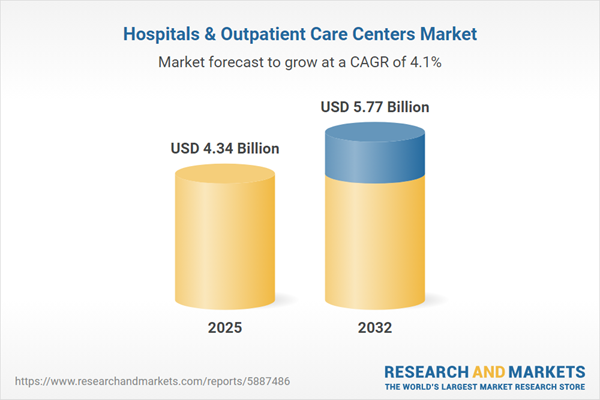Speak directly to the analyst to clarify any post sales queries you may have.
The hospitals and outpatient care centers market is rapidly evolving, with senior healthcare executives responding to new regulations, expanding digital integration, and increasingly complex patient demands. In this environment, timely market intelligence drives strategic differentiation and future readiness.
Market Snapshot: Hospitals and Outpatient Care Centers Market
The global hospitals and outpatient care centers market is on an upward growth path, with market value expected to rise from USD 4.17 billion in 2024 to USD 4.34 billion in 2025, and reaching an anticipated USD 5.77 billion by 2032, equating to a 4.14% compound annual growth rate. This forecasted trajectory is shaped by strong adoption of digital health platforms, new advances in value-based care models, and evolving regulatory requirements. Senior leaders are focusing on digital transformation, building new partnerships, and investing in patient-centric models that support local and global challenges. Continuous advances in health technologies and the drive for operational excellence are fostering a dynamic leadership environment within the sector.
Scope & Segmentation: Strategic Insights for Decision-Makers
A thorough segmentation strategy helps executives identify where to expand, adapt resources, and guide investments in the hospitals and outpatient care centers market. Each segment reflects a key operational lever with direct relevance to competitive positioning and long-term resilience:
- Service Types: Emergency care, inpatient specialties, ambulatory surgery, diagnostic imaging, dialysis, and rehabilitation each contribute to a holistic and integrated approach to patient care while offering opportunities to improve clinical efficiency and outcomes.
- Facility Types: Ambulatory surgery centers, imaging centers, full-service hospitals, dialysis units, rehabilitation clinics, and urgent care facilities support diverse care pathways and enable organizations to respond more effectively to shifts in patient needs.
- Ownership Models: Private for-profit, nonprofit, and public organizations require distinct management strategies, with implications for investment, compliance, and risk exposure tailored by ownership structure.
- Payer Types: Medicaid, Medicare, private insurance, self-pay, and uninsured groups influence revenue cycles and shape strategies for financial sustainability as payment and reimbursement frameworks mature.
- Patient Age Groups: Adult, pediatric, and geriatric populations demand tailored approaches and digital tools to enable targeted care delivery for diverse demographic needs.
- Regions Covered: Americas, Europe, Middle East & Africa, and Asia-Pacific each offer unique regulatory, economic, and operational landscapes, requiring adaptive strategies and localized risk management.
- Coverage of Key Providers: Leading groups such as Kaiser Foundation Health Plan, HCA Healthcare, CommonSpirit Health, and Ascension Health establish performance benchmarks and inform the development of best practices and operational enhancements.
Strong segmentation enables organizations to maintain flexibility, strengthen coordination across service lines, and address the evolving spectrum of patient demand while effectively managing compliance and operational risks.
Key Takeaways for Executive Strategy
- Diversified care offerings help organizations meet evolving patient expectations and stay competitive in a changing healthcare environment.
- The use of digital health solutions, such as virtual care and clinical informatics, supports improved workflow efficiency and rapid service scaling across facilities.
- Adaptable governance models, aligned with ownership structures, enhance cross-stakeholder collaboration and build regulatory strength.
- Strategic payer relationships and a balanced patient mix are essential for ongoing financial stability as reimbursement models adapt.
- Tailored regional strategies drive compliance effectiveness and broaden market access in response to local regulatory demands.
- Coordinated integration of various facility types delivers seamless patient transitions and contributes to consistent care quality improvements.
Tariff Impact on Provider Operations
Expected tariffs on healthcare devices, equipment, and pharmaceuticals are influencing how providers approach supplier selection and operational planning. Senior leaders are advised to diversify supplier networks, revise contract terms, and enhance inventory oversight to support business continuity. Local supplier collaborations and prudent use of regulatory waivers can help mitigate potential disruptions and protect continuity of care.
Methodology & Data Sources
This report is built on direct interviews with senior healthcare decision-makers, supplemented by input from clinical and procurement specialists. Findings are rigorously cross-checked against current market conditions and regulatory trends to offer actionable, data-driven recommendations.
Why This Report Matters
- Enables targeted market segmentation and robust governance analysis for confident, evidence-based decision-making.
- Presents actionable frameworks around digital transformation and regulatory adaptation for effective operational redesign.
- Benchmarks approaches used by leading sector providers, supporting informed risk management and strategic organizational enhancements.
Conclusion
This report offers senior executives a strategic resource to advance regulatory compliance and improve operational performance, establishing a strong foundation for resilient progress in an evolving healthcare market.
Additional Product Information:
- Purchase of this report includes 1 year online access with quarterly updates.
- This report can be updated on request. Please contact our Customer Experience team using the Ask a Question widget on our website.
Table of Contents
3. Executive Summary
4. Market Overview
7. Cumulative Impact of Artificial Intelligence 2025
Companies Mentioned
The companies profiled in this Hospitals & Outpatient Care Centers market report include:- Kaiser Foundation Health Plan, Inc.
- HCA Healthcare, Inc.
- CommonSpirit Health
- Ascension Health, Inc.
- Providence St. Joseph Health
- University of Pittsburgh Medical Center
- Mayo Foundation for Medical Education and Research
- Tenet Healthcare Corporation
- AdventHealth, Inc.
- Community Health Systems, Inc.
Table Information
| Report Attribute | Details |
|---|---|
| No. of Pages | 189 |
| Published | October 2025 |
| Forecast Period | 2025 - 2032 |
| Estimated Market Value ( USD | $ 4.34 Billion |
| Forecasted Market Value ( USD | $ 5.77 Billion |
| Compound Annual Growth Rate | 4.1% |
| Regions Covered | Global |
| No. of Companies Mentioned | 11 |









